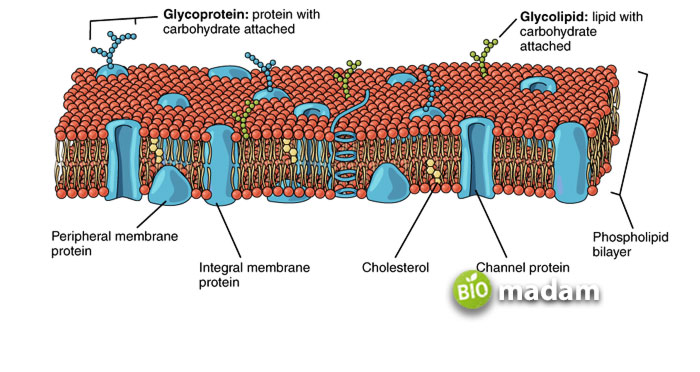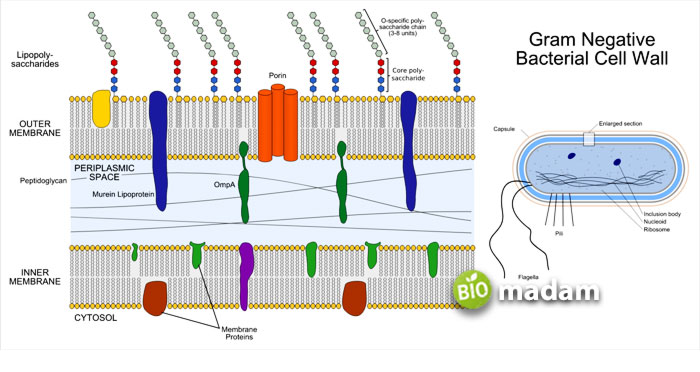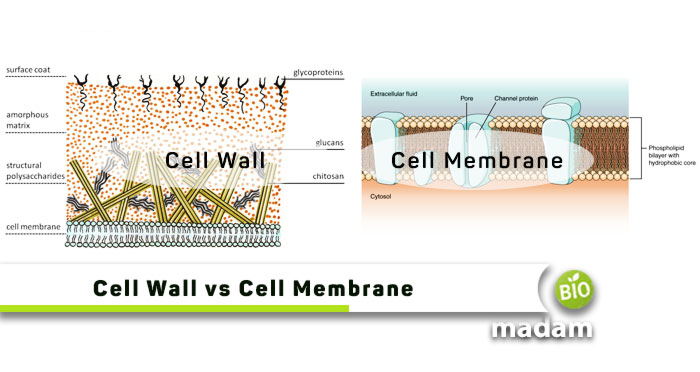The cell membrane and cell wall are an essential part of all living cells – plants, animals, and fungi.
The cell wall and cell membrane are the outermost layers of plants and animals, respectively. These provide structural support to living cells. A cell membrane is present in all living cells, whereas, the cell wall is absent in animal cells. Algae, fungi, and bacteria also have cell walls. The plasma cell membrane is the inner layer, after the cell wall in plants. Let’s talk about other differences between the two, and we will start with a brief comparison table.
Comparison Table
| Characteristic | Cell Wall | Cell Membrane |
| Presence | Plants, fungi, algae, & bacteria | All living cells |
| Thickness | 4 – 20 µm | 5 – 10 nm |
| Composition | Cellulose/chitin/pectin/ murein/pseudomurein | Lipids, proteins, carbs |
| Rigidity | Thick and rigid | Thin and flexible |
| Permeability | 30 – 60 kDa molecules | Nonpolar molecules |
| Receptors | Absent | Present |
| Metabolic Activity | Absent | Present |
| Growth | Grows with cell age | Stays the same |
What is a Cell Membrane?
The cell membrane is the outermost layer in animals and is present next to the cell wall in plants, algae, and fungi. It has a significant role in the structure and supports the organism. It is widely known as the plasma membrane, but the two terminologies are different.
The cell membrane is made of a type of protein and lipids in the form of the fluid mosaic model. The model suggests that the proteins are embedded in the lipid bilayer. Proteins make up 50 percent of the membrane, and lipids are present in the form of liposomes. It also contains carbohydrates (glycoproteins and glycolipids). This layer facilitates the transport of proteins and lipids across the plasma membrane. The hydrophobic interactions are thought to be a significant contributor to the formation of the lipid bilayer.
Transport of all kinds takes place across the membrane. Organic and ionic molecules can pass easily through the semi-permeable membrane. Though it does not encourage the movement of polar substances, non-polar molecules pass the membrane through osmosis and diffusion. Besides the lipid bilayer membrane, phosphatidylserine creates an additional barrier. The transport of materials in and out of the cells properly allows for maintaining a constant environment.

Functions of Cell Membrane
The cell membrane is the primary component of the cell that protects it from the outside environment. It also provides shape and support to the cell. Functions of the cell membrane include:
- Providing support to the cell structure
- Protecting the interior cell from the extracellular environment
- Transport of material through the membrane to regulate functions
- Allows passing only selected ions and molecules across the semi-permeable membrane
- Facilitates communication across the cell
What is a Cell Wall?
A cell wall is an extra membrane present in plants, fungi, and various classes of algae, however, is absent in animals. A cell wall adds to the support of these cells and prevents overexpansion. Algae, plants, and fungi all have different kinds of cell walls with unique compositions.
The plant cell wall is the most detailed structure, which consists of three parts – primary cell wall, secondary cell wall, and middle lamella. The primary cell wall is composed of cellulose, carbohydrates, and hemicellulose. It is comparatively thin. On the other hand, the secondary cell wall is thick and contains xylan, lignin, cellulose, and proteins. The middle lamella is rich in pectin.
The fungal cell wall contains proteins, chitin, and glucans. The Algae cell wall consists of cellulose. The bacterial cell wall is composed of murein, and the archeal cell wall has pseudomureins in the structure. The cell wall also helps in determining if it is a gram-negative or gram-positive bacteria. They are classified according to the stain the cell membrane takes.

Functions of the Cell Wall
The cell wall is similar to the cell membrane in maintaining cell structure. It provides a rigid shape to the plant cell. However, it also contributes to cell growth. Here are the functions of the cell wall:
- Protecting the cell from the outside environment, pathogens, and antigens.
- Providing structural support and strength to the prokaryotes and eukaryotes.
- Storing carbohydrates essential for seed growth
- Allowing the passage of small molecules easily
- Controlling the direction of cell growth
- Preventing overexpansion of the cell
Similarities between Cell Wall and Cell Membrane
Besides the differences, the cell membrane and cell wall are basic cell components. They have similar structures and functions. Some of the similarities between them are:
- Both allow the passage of specific molecules.
- They play an integral role in maintaining the shape and structure of the cell.
- The cell wall and cell membrane protect the cell from the outside environment.
- They surround the cell interior.
Differences between Cell Wall and Cell Membrane
Definition
Cell Wall
A cell wall is the outermost membrane of plant cells, fungi, algae, and many bacteria.
Cell Membrane
On the contrary, the cell membrane is the outermost layer in all eukaryotes and prokaryotes.
Presence
Cell Wall
A cell wall is found in algae, bacteria, fungi, and plants, but is absent in animal cells.
Cell Membrane
On the contrary, a cell membrane is present in all cells. It exists beneath the cell wall in cells having these rigid structures.
Thickness
Cell Wall
The cell wall is typically 4-20 µm in thickness.
Cell Membrane
Alternatively, the thickness of the cell membrane is 5–10 nm, which is thinner than the cell wall.
Composition
Cell Wall
The cell wall comprises varying components in each kind of organism. It is commonly made of chitin, murein, lignin, pectin, pseudomurein, cellulose, and carbohydrates.
Cell Membrane
Whereas, the cell membrane is composed of a lipid bilayer that contains lipids, proteins, and carbohydrates.
Rigidity
Cell Wall
The cell wall is thicker and more rigid than the cell membrane.
Cell Membrane
On the other hand, the cell membrane is not rigid and changes its shape slightly per need.
Permeability
Cell Wall
The cell wall is completely permeable to smaller 30 – 60 kDa molecules.
Cell Membrane
Conversely, the cell membrane is semi-permeable and allows the movement of non-polar molecules only.
Receptors
Cell Wall
When it comes to receptors, the cell walls lack at having receptors.
Cell Membrane
In comparison, the cell membrane has receptors that help signal and communicate across the cell.
Metabolic Activity
Cell Wall
The cell wall is metabolically inactive.
Cell Membrane
Conversely, the cell membrane is metabolically active and involved in various functions.
Nutritional Requirements
Cell Wall
As the cell wall is dead, it only acts as a storage unit and does not require nutrients.
Cell Membrane
Alternatively, the cell membrane is alive and requires nutrients to function properly.
Growth
Cell Wall
The cell wall grows as the cell gets older. It eventually takes the whole of the cell space as the cell dies.
Cell Membrane
Yet, the cell membrane is of the same size and thickness throughout the cell’s lifetime.
The Bottom Line
The cell wall and cell membrane are essential parts of the cell for growth and structural support. Though they vary in some functions, they both are involved in the to and fro transport of materials. The cell wall also regulates the growth of plant cells. The cell membrane is found in all living cells, however, the cell wall is absent in animal cells. The fluid mosaic model with a lipid bilayer depicts the cell membrane’s structure. On the other hand, the cell wall may be composed of chitin, cellulose, pectin, murein, and pseudomurein.

Anna has completed her degree in Pharmacy from the University of Hawaii. She is serving as a research assistant in a pharmaceutical company. She had a great interest in writing blogs, traveling to different parts of the US, and trying delicious recipes in her spare time.

